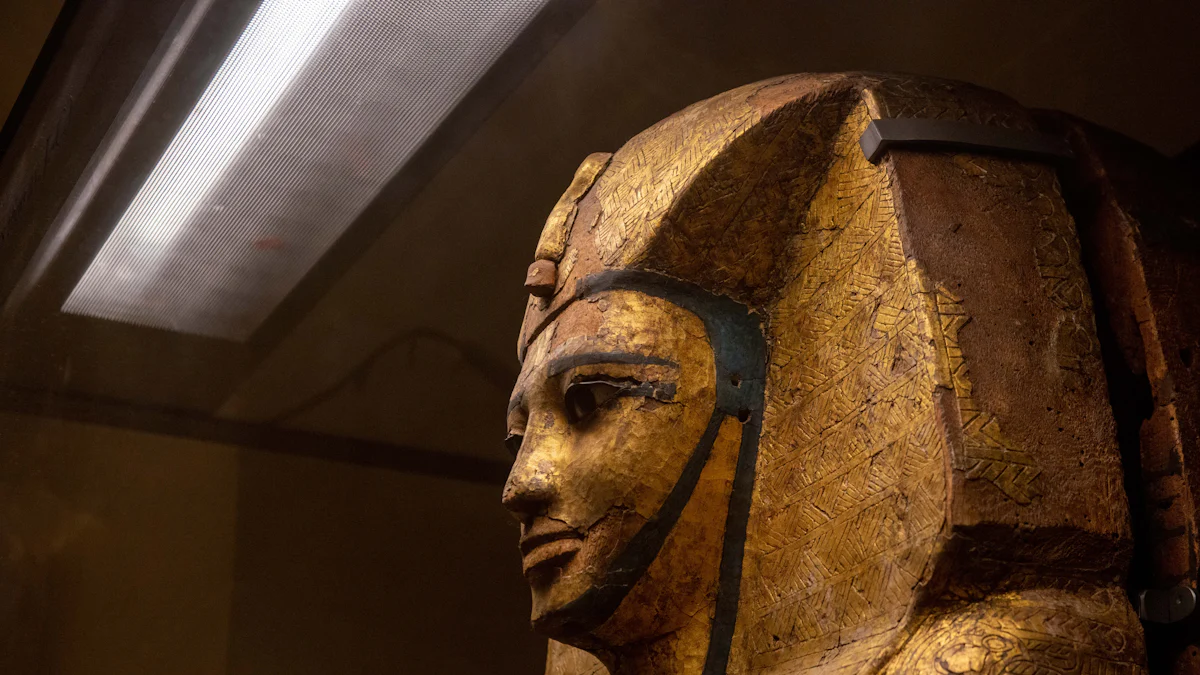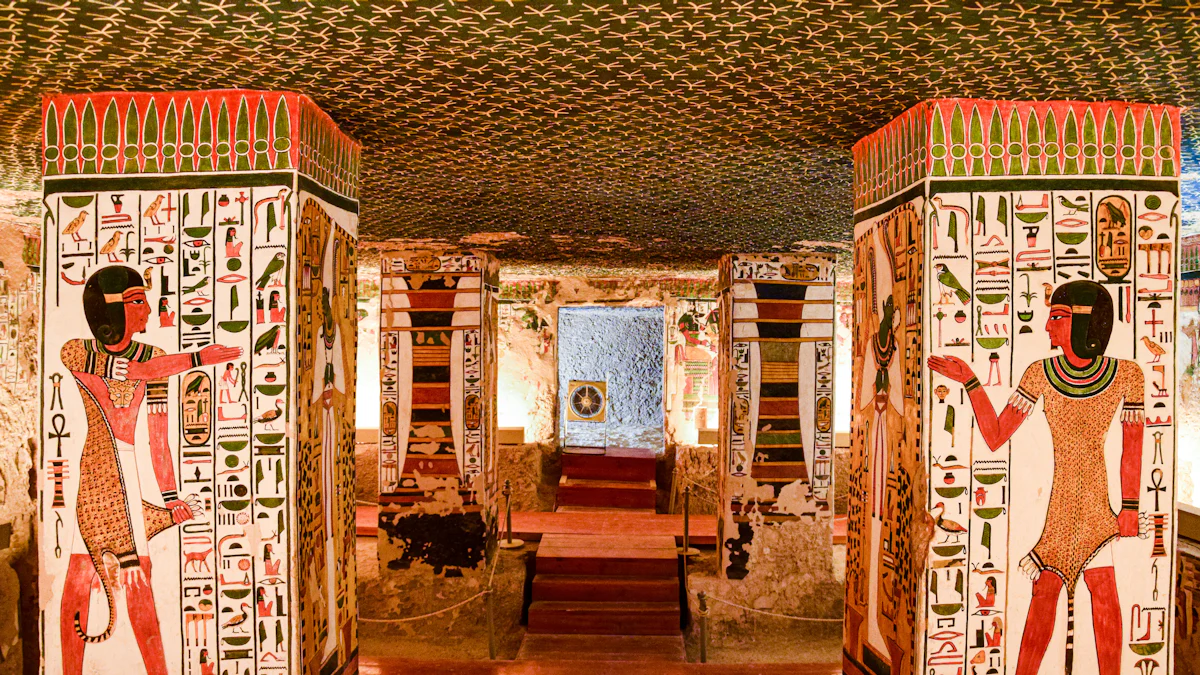The Complete Tutankhamun: 100 Years of Discovery

Tutankhamun, commonly known as the "Boy King," continues to be one of the most mysterious figures in ancient Egypt. The unearthing of his tomb in Egypt's Valley of the Kings in 1922 by Howard Carter and Lord Carnarvon was a groundbreaking event in the field of archaeology. This discovery enthralled the world with its abundance of treasures and profound insights into Egyptian culture. As we celebrate the centennial of this remarkable find, its lasting importance is more evident than ever. Over the past century, Tutankhamun's tomb has attracted millions of visitors to exhibitions around the globe, underscoring the enduring fascination with Egypt's ancient history.
The Historical Background
Ancient Egypt and the Pharaohs
The Role of Pharaohs in Egyptian Society
Pharaohs held supreme power in ancient Egyptian society. These rulers were considered divine beings, bridging the gap between gods and humans. The Pharaoh's role encompassed religious, political, and military leadership. Egyptians believed that the Pharaoh maintained order and harmony in the universe. The Pharaoh performed rituals to honor the gods and ensured the prosperity of the land. The Pharaoh's authority extended over all aspects of life, from lawmaking to overseeing construction projects.
Tutankhamun's Place in History
Tutankhamun, known as the "Boy King," ascended the throne at a young age. His reign marked a period of restoration in ancient Egypt. Tutankhamun's predecessors had introduced religious reforms, which he reversed. The young Pharaoh reinstated traditional Egyptian deities and practices. Despite his short reign, Tutankhamun's tomb discovery elevated his status in history. The intact nature of the tomb provided unparalleled insights into ancient Egyptian culture and burial practices.
The Valley of the Kings

Significance of the Valley
The Valley of the Kings served as the burial ground for Pharaohs and nobles during the New Kingdom period. This site offered protection from tomb robbers due to its remote location. The valley's significance lay in its concentration of royal tombs, each filled with treasures and artifacts. The tombs reflected the wealth and power of ancient Egyptian rulers. The Valley of the Kings became a symbol of the grandeur of ancient Egyptian civilization.
Previous Discoveries Before Tutankhamun
Before the discovery of Tutankhamun's tomb, archaeologists had unearthed several other royal tombs in the Valley of the Kings. These discoveries revealed the richness of ancient Egyptian burial traditions. However, many tombs had suffered from looting over the centuries. The discovery of Tutankhamun's tomb in 1922 by Howard Carter changed the course of archaeology. The tomb stood out as one of the most intact pharaonic tombs ever found. The treasures within captivated the world and deepened the understanding of ancient Egyptian history.
The Discovery of the Tomb
Howard Carter and Lord Carnarvon
The Partnership and Initial Exploration
British archaeologist Howard Carter formed a significant partnership with Lord Carnarvon. This collaboration began in the early 20th century. Lord Carnarvon provided financial support for the excavation efforts. Carter's expertise in archaeology guided the exploration process. The team focused on Egypt's Valley of the Kings. The search for Tutankhamun's tomb required persistence and dedication.
Carter's experience with Flinders Petrie shaped his approach. Petrie emphasized the importance of small finds. Carter applied these principles during the excavation. The team faced numerous challenges, including harsh conditions. The determination of both Carter and Lord Carnarvon played a crucial role. Their combined efforts eventually led to a groundbreaking discovery.
The Moment of Discovery
The moment of discovery occurred on November 4, 1922. Carter's team uncovered a hidden staircase. This staircase led to the entrance of Tutankhamun's tomb. Carter peered inside through a small hole. The sight amazed him. Carter famously exclaimed, "Yes, wonderful things!" The tomb contained a wealth of treasures and artifacts. The discovery captivated the world and marked a milestone in archaeology.
The Excavation Process
Challenges Faced During Excavation
The excavation process presented several challenges. Carter and his team worked in difficult conditions. The Valley of the Kings posed environmental obstacles. The team had to dig through hundreds of boulders. The excavation required careful planning and execution. Carter's meticulous record-keeping proved invaluable. His notebooks remain a vital resource for researchers today.
The team faced logistical difficulties as well. Transporting artifacts required precision and care. The preservation of delicate items demanded expertise. Carter's innovative classification system aided the process. This system helped organize the vast array of discoveries. The excavation of Tutankhamun's tomb set new standards in archaeology.
Key Findings and Artifacts
The tomb revealed an extraordinary collection of artifacts. The treasures included gold-covered chariots and intricately carved vessels. Jewelry and personal belongings of Tutankhamun were also found. Each item provided insights into ancient Egyptian culture. The sarcophagus and mummy of Tutankhamun held particular significance. These findings enriched the understanding of pharaonic burial practices.
Carter's discovery transformed the field of Egyptology. The intact nature of the tomb offered unparalleled opportunities for study. The artifacts continue to inspire fascination and research. The legacy of Howard Carter and Lord Carnarvon's discovery endures to this day.
The Contents of the Tomb

The Treasures of Tutankhamun
Iconic Artifacts and Their Significance
The discovery of King Tut's tomb revealed a dazzling array of treasures. Gold statues, ornate jewelry, and gilded furniture filled the chambers. Each artifact showcased the wealth and artistry of the young Egyptian king. The tomb contained cosmetics and personal items, reflecting daily life in ancient Egypt. Objects like Hatnefer’s linen sheets and shirts provided insights into the era's lifestyle.
The treasures offered a glimpse into the material world of Dynasty 18. The Archaeological Institute of America recognized the tomb as the most intact Egyptian tomb ever found. These findings enriched the understanding of pharaonic burial practices. The artifacts continue to captivate scholars and enthusiasts alike.
The Sarcophagus and Mummy
The sarcophagus of pharaoh Tutankhamun held immense significance. Crafted with exquisite detail, the sarcophagus protected the mummy of the scarcely studied Pharaoh Tutankhamun. The burial chamber contained multiple layers of coffins, each more elaborate than the last. The innermost coffin, made of solid gold, symbolized the king's divine status.
The mummy of King Tut provided valuable information about his life and death. Modern technology, such as CT-scanning, has unveiled new details about the young king. Researchers have studied Pharaoh Tutankhamun immediately to understand more about ancient Egyptian health and genetics.
The Symbolism and Artistry
Artistic Techniques Used
Ancient Egyptian art in the tomb displayed remarkable craftsmanship. Artisans employed techniques like inlaying and gilding to create stunning effects. The use of vibrant colors and intricate designs highlighted the skill of ancient artists. The tomb's decorations reflected religious beliefs and cultural values.
The artistic techniques used in the tomb set a standard for future archaeological studies. The Getty and the Griffith Institute in Oxford have preserved many of these artworks. Scholars continue to study these pieces to gain insights into ancient Egyptian art.
Symbolic Meanings of the Artifacts
The artifacts in King Tut's tomb held deep symbolic meanings. Many items represented protection and guidance for the afterlife. Symbols like the scarab beetle and the ankh adorned various objects. These symbols conveyed messages of rebirth and eternal life.
The Nile River played a crucial role in the symbolism within the tomb. The river symbolized fertility and sustenance, essential for the king's journey to the afterlife. The tomb's contents reflected the religious beliefs of the time, influenced by figures like Akhenaten. The discovery of King Tut continues to inspire fascination and research.
The Cultural Impact
Influence on Archaeology
Advancements in Archaeological Methods
The discovery of Tutankhamun's tomb revolutionized archaeological methods. Howard Carter's meticulous approach set new standards for excavation. Researchers adopted systematic recording and preservation techniques. The Egyptian Museum in Cairo became a hub for these advancements. Scholars gained insights into ancient Egyptian burial practices. The Grand Egyptian Museum continues to showcase these findings.
Increased Interest in Egyptology
Tutankhamun's tomb sparked global interest in Egyptology. The treasures captivated the public's imagination. Exhibitions at the Egyptian Museum in Cairo drew massive crowds. The Grand Egyptian Museum now attracts visitors worldwide. This fascination fueled further research into Egyptian history. Scholars explored the rich tapestry of ancient Egyptian culture.
Tutankhamun in Popular Culture
Exhibitions and Public Fascination
The Treasures of Tutankhamun exhibition in 1972 broke records. The British Museum hosted over 1.6 million visitors. This event reignited cultural obsession with ancient Egypt. The Egyptian Museum in Cairo continued to display these artifacts. The Grand Egyptian Museum now houses many of these treasures. Public fascination with Egyptian history remains strong.
Representation in Media and Literature
Tutankhamun inspired countless works in media and literature. The film The Mummy depicted a sensationalized version of his discovery. Boris Karloff's portrayal of the resurrected mummy thrilled audiences. The film referenced the lore of the mummy's curse. This narrative echoed the excitement surrounding Tutankhamun's tomb. Books and documentaries explored Egyptian themes further.
The Metropolitan Museum Egyptian Expedition
Role in the Discovery of King Tut
The Metropolitan Museum played a pivotal role in the discovery of King Tut's tomb. The collaboration between Howard Carter and the Metropolitan Museum Egyptian Expedition proved invaluable. The Museum's involvement provided essential resources and expertise. The Department of Egyptian Art at the Metropolitan Museum contributed significantly to the excavation efforts. The Museum's support helped ensure the success of the expedition.
Contributions to the Excavation
The Metropolitan Museum's contributions to the excavation of Tutankhamun's tomb were substantial. The Museum provided financial backing and technical expertise. The Department of Egyptian Art offered insights into ancient Egyptian culture and burial practices. The Museum's team worked closely with Howard Carter during the excavation process. The collaboration resulted in a more comprehensive understanding of the tomb's contents.
The Metropolitan Museum of Art's collection includes several artifacts from Tutankhamun's tomb. The Museum's research confirmed the origin of 19 objects in its collection. These artifacts offer a glimpse into the life and times of the young pharaoh. The Museum's acknowledgment of Egypt's title to these objects highlights the importance of preserving cultural heritage. The Museum of Art Bulletin published detailed findings on the artifacts' origins.
Impact on the Understanding of Ancient Egypt
The Metropolitan Museum's involvement in the excavation of Tutankhamun's tomb had a lasting impact on the understanding of ancient Egypt. The Museum's research expanded knowledge of Egyptian art and culture. The Department of Egyptian Art played a crucial role in analyzing the artifacts. The findings provided valuable insights into the religious and artistic practices of the time.
The Metropolitan Museum's work continues to influence modern Egyptology. The Museum's exhibitions showcase the richness of ancient Egyptian art. The Princeton University Art Museum collaborates with the Metropolitan Museum to further explore Egyptian history. The Museum's commitment to education and research supports JSTOR Daily in providing accessible information on ancient Egypt.
The Metropolitan Museum remains a leader in the field of Egyptology. The Museum's dedication to preserving and sharing knowledge enriches the global understanding of Tutankhamun's legacy. The Museum's efforts ensure that future generations can appreciate the wonders of ancient Egyptian civilization.
Tutankhamun's discovery continues to captivate the world. The treasures and insights from his tomb offer a profound connection to ancient Egypt. Ongoing research in Egyptology reveals new findings, enhancing our understanding of this civilization. Preserving cultural heritage remains vital. These artifacts teach lessons on tolerance and respect for diversity. Protecting such heritage fosters intercultural dialogue and enriches our identity. The legacy of Tutankhamun inspires future generations to appreciate history's wonders.
See Also
Egypt's Riches: A Heritage in Pictures From Pyramids to Cleopatra
Illustrated History of Ancient Egypt

